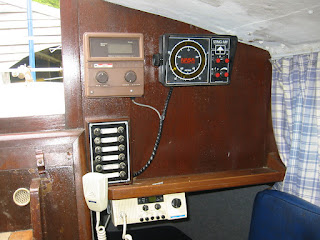Bear with me. This Blog is about renovating a boat – but
there is a context, the boat and its owner are English, the location is France
– and that makes some things different – not better or worse – just different.
In my last post I reported that my boat was built to UK
specifications (Imperial measurements) good old feet and inches, whereas my
tools seem to be all metric. As a result I had to resort to some drastic
measures to remove some items from her. It felt more like vandalism that
restoration. Well, now here are a few other differences I have encountered this
week.

Firstly, I have discovered the ‘price’ of living in a truly
beautiful rural area – distances are vast and fuel bills are high. Popping down
to my nearest chandler is a thirty mile round trip. It’s a beautiful trip but a
long way to go for a stainless steel jubilee clip. Careful planning and
thinking ahead doesn’t pay dividends but it keeps costs down. It’s even harder
to find Marine ply in the sizes I require. My first port of call was Bois Marine
at St Malo – they had the stuff alright but only as full size metric equivalents
of standard 8’x4’ sheets. For smaller amounts I was advised to contact
individual boat builders to see if they have suitable off-cuts from other jobs.
These tend to be sole traders or family businesses and their premises are only
open when they are around. A builder who gains a few days work down at the
marina may not bother to open his yard for several days on end.
Well that’s OK; I have time, so a day spent touring boatyards
in the hope that one or two will be open is no great hardship for me – in fact
I enjoy it, except for the two and a half hour’s ‘dead’ period between noon and
two thirty when there is no point visiting anywhere at all because the entire
region (many supermarkets included) is ‘at lunch’. It’s a different approach to life, and its
one of the things that attracted me here so I’m not complaining but on occasion
I have been left kicking my heals in some pretty distant and obscure places
waiting for the end of a long lunch break only to be told that the item I’m
seeking is not available.

When it comes to hard wood, I have admitted defeat. The
original wood on this boat was Iroko (called African Teak by the builder) but this
area of France is full of Oak. Excellent mature Oak is available everywhere –
Teak, Iroko and Mahogany are considered to be rare and exotic. As a result
these species are difficult to locate and extremely expensive so any new wood
brought aboard will be have to be Oak.
The strangest thing however, was my encounter with
bilge-paint. I have decided that all the bilges should be cleaned and
re-painted. This decision is not based on an obsessive desire for neatness or
cleanliness, rather a practical view that clean bilges are a good indicator of
a boat’s health. If, for example, I launch with pristine bilges and subsequently
discover rust stains or watermarks, I can assume I have a problem in that
location. If however, I launch with dirty oil and water stained bilges I might
not know I have a problem until seawater laps around by ears.

Now, to my simple eye, Red Danboline (International Paints)
is the best. I have used it before, it brings bilges back to ‘as-new’
condition, and oil, rust or water make obvious stains on it. International Paints produce Danboline in Red
and Gray (possibly white also). For some reason however, the red isn’t
available in France. Now this isn’t simply an oversight on the part of
International Paints, it is a decision that someone has taken. Red Damboline is
actually marked as ‘unavailable in France’ in their publicity. Fortunately I
visited the UK recently and came back with some from there. So is there
something about the Red Damboline that the French authorities know about? Something
sinister? Toxic? Dangerous? If so, I wish they’d tell me.
Seaward
 So, last week it was back to the books looking for
alternative ideas. I eventually came across something in a long out-of-date
work – ‘The Marlinspike Sailor’ written by Hervey Garrett Smith (David & Charles 1972). In this book he describes a number of
rope mats that were made up out of old used rope to serve a variety of purposes
on the old nineteenth century square-riggers. Some were known as ‘thump mats’
laid on deck around blocks to protect the wood when tension came off the rope
and the block would clatter onto the deck. Others were used to protect decks in
port when landsmen would come aboard bringing grit on the soles of their shoes.
Some were made to provide non-slip surfaces for crew in key areas.
So, last week it was back to the books looking for
alternative ideas. I eventually came across something in a long out-of-date
work – ‘The Marlinspike Sailor’ written by Hervey Garrett Smith (David & Charles 1972). In this book he describes a number of
rope mats that were made up out of old used rope to serve a variety of purposes
on the old nineteenth century square-riggers. Some were known as ‘thump mats’
laid on deck around blocks to protect the wood when tension came off the rope
and the block would clatter onto the deck. Others were used to protect decks in
port when landsmen would come aboard bringing grit on the soles of their shoes.
Some were made to provide non-slip surfaces for crew in key areas.







